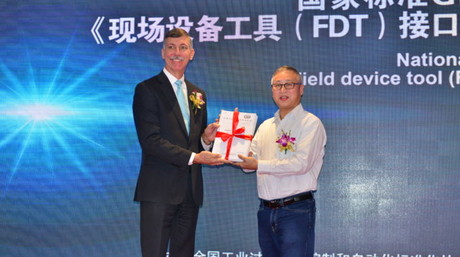China adopts FDT technology as national standard
Friday, 12 January, 2018

FDT Group has announced that a cooperative initiative undertaken between the Group and Chinese standards organisations has resulted in a Chinese national standard for device integration based on FDT 2.0 technology. The collaboration involved China’s National TC124 On Industrial Process Measurement, Control and Automation of SAC (TC124/SAC); Instrumentation Technology and Economy Institute, P.R. China (ITEI); China Instrument Manufacturer Association (CIMA); Southwest University; and the FDT Professional Committee.
The Chinese GB/T 29618-2017 Field Device Tool (FDT) Interface Specification incorporates the latest technology enhancements by the FDT Group, an international non-profit corporation dedicated to providing an open standard for industrial enterprise-wide network and asset integration. The updated standard was announced at a joint organisational meeting held on 15 November in Beijing.
Ongoing advancement of FDT technology is leveraging major developments like the Industrial Internet of Things (IIoT) and Industry 4.0 to enable end users to realise the true potential of decentralisation, interoperability and integration, as well as a unified view of all data and functions across process, factory and hybrid control applications.
The FDT 2.0 specification, employing a futureproof architecture based on Microsoft .NET technology, offers all the properties needed by modern software right up to web- and client/server-based systems. Release of the GB/T 29618-2017 standard incorporating FDT 2.0 will better guide the integration and application of various fieldbuses and devices, and help promote the widespread implementation of standards-based automation solutions.
According to Tian Zhaoying, vice director of the 2nd Industry Department, Standardization Administration, People’s Republic of China (SAP), standardisation is an important requirement for intelligent manufacturing. “The purpose of our ongoing efforts is to enable the effective implementation of advanced industrial standards while promoting social and economic development within China,” he said. “The Chinese FDT Professional Committee and ITEI actively assisted the development of FDT so this advanced technology could be widely implemented by our country’s manufacturing community.”
Mei Ke, vice president of ITEI, believes the updated FDT 2.0 specification will meet current requirements for standardising communication and configuration interfaces between field devices and host systems, and is a key tool for the integration of intelligent manufacturing centres.
Li Yueguang, vice president of CIMA, also noted the technical advantages of FDT 2.0 in system integration and interconnection, and expressed hope that domestic enterprises in China would quickly integrate compliant solutions as part of their smart manufacturing strategies.
FDT Group Managing Director Glenn Schulz expressed gratitude for establishment of the Chinese national standard for device integration technology. “There is growing demand for FDT-enabled solutions employing FDT 2.0 technology in developing industrial markets around the world,” Schulz said. “Based on robust .NET technology, the FDT 2.0 standard maintains proven FDT heritage, but includes numerous performance enhancements while ensuring backward compatibility with our existing installed base.”
FDT was built to support a comprehensive, open architecture for the connected world of industrial automation networks and assets. The backbone architecture, standardised independent of industrial automation networks, allows for a comprehensive networking integration model allowing for seamless integration mapping to connect intelligent assets relaying device-specific diagnostics data enterprise-wide.
Newmont deploys 'world first' 5G teleremote dozer fleet at Cadia mine
The capacity and predictability of private 5G boosts mining construction fleet efficiency.
OPC Foundation releases 'Secure by Demand' document
The OPC Foundation has released guidance for operational technology owners and operators when...
Over-the-air vulnerabilities discovered in Advantech EKI access points
Analysis of three models of Advantech EKI-6333AC industrial wireless access points have...








